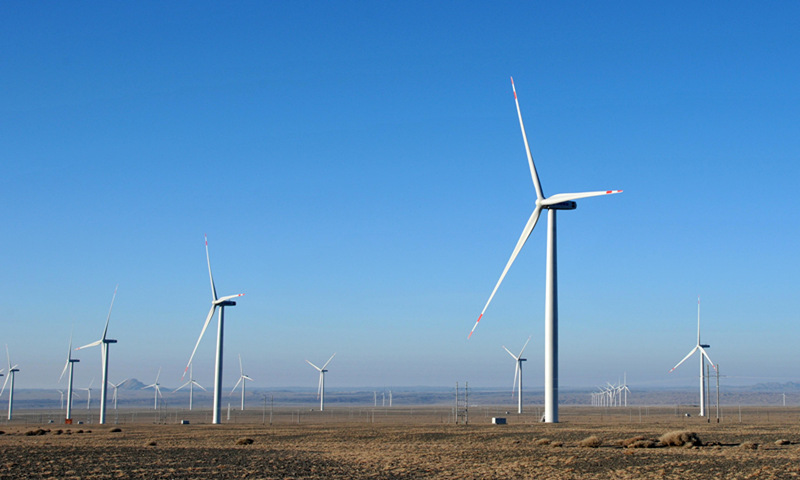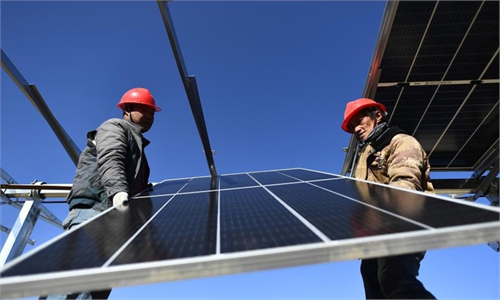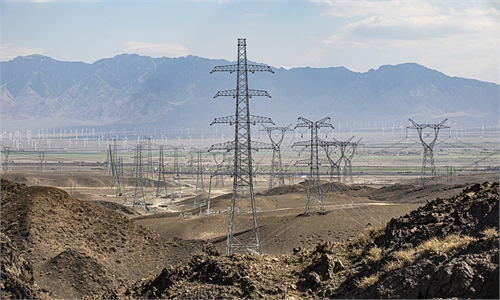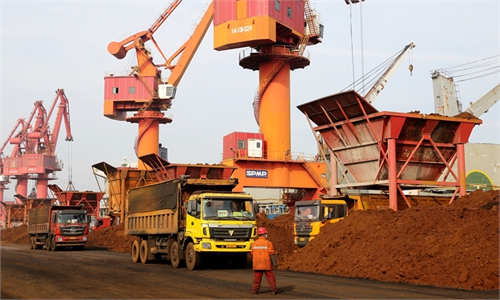China attaches great importance to regional power shortages amid rising demand, new-energy ambition
Impact is regional, temporary, but offers sober lessons

Wind turbines run smoothly in Qitai county in Northwest China's Xinjiang Uygur Autonomous Region. Bordering Mongolia and located east of the Altay Mountains, the county is known as "the hometown of wind" for its strong year-round gusts that sometimes annoy residents. With investment by wind power enterprises, the county has become a new energy base with an annual capacity of 1.7 million kilowatts. Photo: cnsphoto
China has run into a regional power shortage with multiple localities having curbed electricity use and imposed rationing in recent days, drawing a wide array of discussions on Chinese social media platforms, as the country scales up its green energy ladder to expand the share of renewables in its energy mix to meet its ambitious climate goal to reach carbon neutrality by 2060.
China's top economic planner vowed on Monday at a press conference held by the State Council Information Office that China's power supply is overall smooth and orderly and that civilian use of electricity will be guaranteed.
Power shortages and rationing have been experienced in Central China's Hunan Province and East China's Jiangxi and Zhejiang provinces, affecting industrial and civilian power use.
Certain areas in North China's Inner Mongolia Autonomous Region were also affected and a top-four Chinese city, Guangzhou in South China's Guangdong Province, also experienced a brief blackout on Monday morning, though a fault in electrical wires rather than tight power supply caused the malfunction.
In Hunan, high-energy consumption sectors, such as copper smelting, were among the most affected.
Prices for a large number of commodities including aluminum, copper, cement and steel are at their best levels for the year, as countless factories and plants in China are ramping up their production capacity after picking up a massive amount of orders placed by customers from around the world for the overseas market, in the wake of the pandemic that has crippled manufacturing in many countries and regions.
In Changsha, provincial capital of Hunan, central heating in some office buildings have ceased to function. A white-collar employee surnamed Yang told the Global Times that central air conditioning has stopped for a few days but thankfully some heaters can still be used to cope with the cold weather.
A manager at Changsha Jiangtong Copper Co told the Global Times that power rationing has caused "destructive damage" to the sector.
"While the exact losses need to be calculated considering the dynamics of supply and demand, current rationing could potentially lead to millions of yuan in operation profit losses," said the manager who spoke on the condition of anonymity.
A manager at Hunan Yincheng Aluminum Co, surnamed Deng, said they received a notice from the authorities that the use of electricity needs to be kept below 200 kilowatts per hour. "We have two transformers that can provide electricity with 80 kilowatts per hour which can help us operate under the electricity restrictions," the manager told the Global Times.
Gas for heating aluminum ovens is also cut off occasionally. "We have reported the situation to the local authorities, but they said they received a notice to impose a curb on electricity and gas to ensure priority supply to civilian demand," said Deng.
Deng said the bad weather is to blame. "We have been losing money and we don't know when the curb will be lifted," said Deng.
Not all industrial firms are impacted. A staffer with the high-speed train manufacturer CRRC told the Global Times that the company's production remains unaffected.
Hunan is not the only area facing power curbs. Manufacturing companies in Zhejiang are reportedly making emergency purchases of diesel-powered generators.
A video clip on China's Twitter-like Sina Weibo social media platform showed that street lamps in Zhejiang's Yiwu, the world's capital of small commodities, were not lit up.
China's industrial production is picking up, as factories receive orders now their overseas counterparts could not complete, causing a sharp uptick in electricity demand.
"Half of the manufacturing enterprises received orders backing up to 2023, which may cause limitations on residents' electricity usage," a netizen named "Beta Yidali" wrote in a post, without suggesting the location.
The news came as a shock to some in China, with power rationing bringing back memories of China during the last century when rationing was a frequent displeasure. This occurred when China entered a period of rapid industrialization with the capacity of electricity generation often falling behind.
Others are dismayed at such rationing still occurring in today's China, with the country being a major market player in electricity generation, having helped a number of countries including Pakistan, Malta and Brazil to address their own power shortage woes overseas with state-of-the-art equipment and technology.
Some state-run newspapers frankly pointed out that such a situation should not be tolerated.

Energy in China's New Era: White Paper. Graphic: GT
Reasons behind the awkwardness
Multiple factors have overlapped to cause power shortages in the aforementioned provinces, although at the national level, power supply still outstrips demand at large, analysts and industry players said.
However, a decline in the imports of Australian coal after a reported Chinese curb due to quality issues was not mentioned by analysts and industry insiders, and some brushed aside such suggestions as Australian coal accounts for only 2 percent of China's total coal consumption.
Hunan Province is one of China's champions in harnessing renewable energy, with 51 percent of its power coming from clean-energy sources, according to a report by the industry portal cnenergynews.cn.
But the province's distance to major coal producing regions and lackluster hydro power generation in winter means there is a risk of power shortages.
"Rising freight costs to transport coal, cold fronts that arrived earlier than usual and enhanced environmental scrutiny near the year's end as localities present their environmental performances to their superiors were other factors that contributed to the power curb," Lin Boqiang, director of the China Center for Energy Economics Research at Xiamen University, told the Global Times on Monday.
With China's advanced grid system, including ultra-high voltage power lines that can transport electricity over extremely long distances, power can in theory be shifted from other areas to high-demand regions but this requires complex coordination among provinces and also time.
"Rolling back electricity consumption with an administrative order is arguably the easiest way to address temporary woes," an industry insider told the Global Times on Monday.
A high level of growth in industrial production, compounded by cold fronts, have resulted in highly maximized power demands, Zhao Chenxin, deputy secretary-general of the National Development and Reform Commission (NDRC), said Monday.
In the first 10 days of December, electricity production and consumption in Hunan Province rose by 19.8 percent year-on-year with a record peak power load of 31.44 million kilowatts, according to Zhao.
East China's Jiangxi Province saw an 18.4 percent increase in power generation and usage. In Zhejiang, the figure is at 9.2 percent.
In the case of Zhejiang, where local power supplies are supposed to be sufficient, some places in the province opted to curb power consumption in an attempt to boost energy saving and emissions reduction, Zhao said.
Zhao stressed that the country's coal storage at power plants remains guaranteed and the nation can assure stable energy supplies.
Lessons to be learned
Lin said all the factors are within the realm of tolerance as such issues happen every year and must overlap with each other to cause any real trouble for the country.
However, the current situation has rung alarm bells on the rising requirements of a higher renewable energy mix and the effects it may have on the country's grid network.
China has already been the world's largest clean-energy power system that includes the world's largest hydro, wind, and solar networks, an official with the National Energy Administration said earlier this month. Total installed capacity for renewable energy already accounted for over 41 percent of the national total energy mix as of October.
Due to the fact that wind and solar are unable to generate power all the time, three units of new energy installed capacity are needed to compensate for one unit of coal-fired installation.
Lin said new-energy sources, such as wind, solar and hydro power, are comparatively weaker than coal-fired electricity in coping with a sudden uptick in energy demand.
"China, even with its already highly advanced grid network, needs to invest more in the system to ensure the grid can rise up to such periodical challenges," Lin said.
The NDRC official pledged to raise power production capacities, increase supplies of thermal coal via multiple channels, and dispatch power required to address the supply gap temporarily facing some regions.



